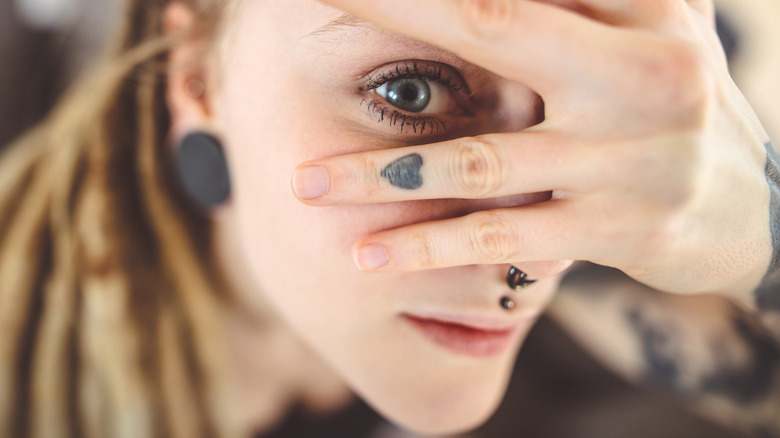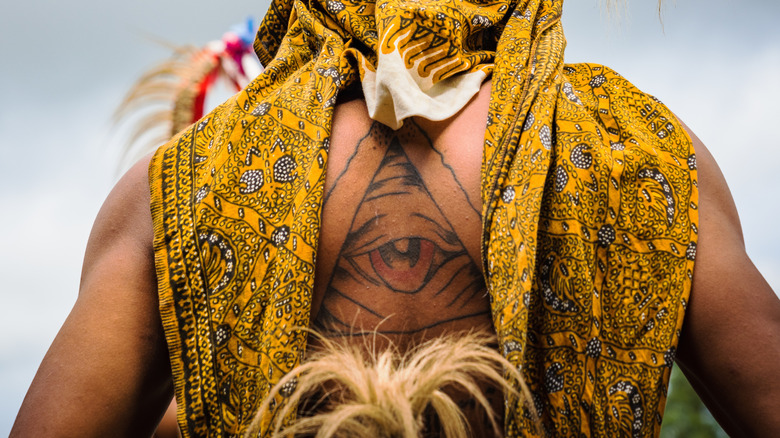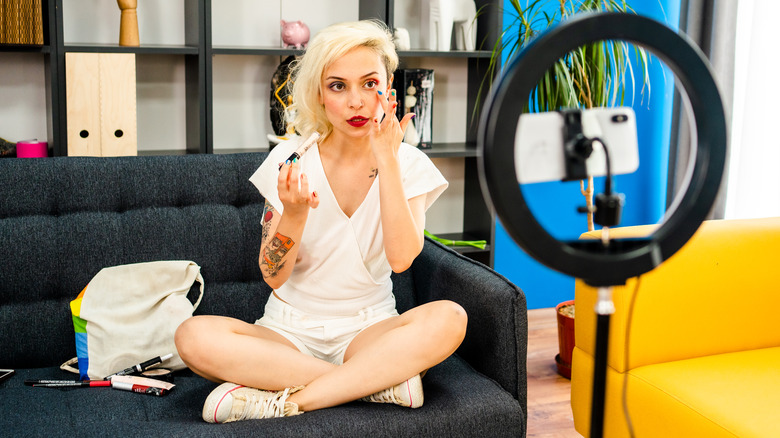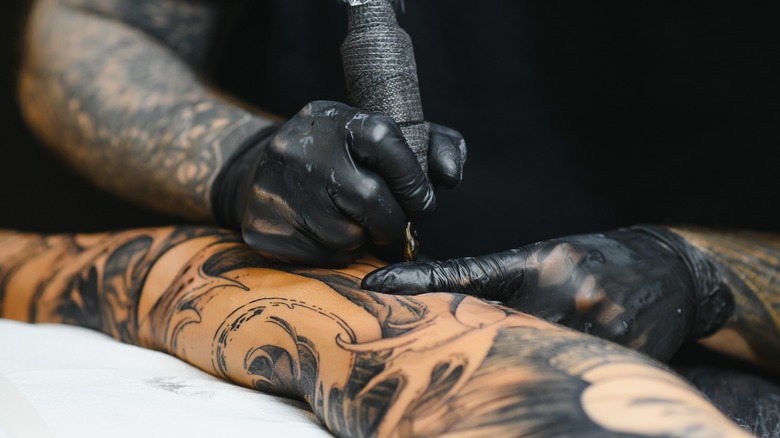Tattoos Have Nearly Doubled In Popularity In The Last 5 Years - And It's No Secret Why
You might have fresh ink on your body, but tattoos have been found on human remains dating back thousands of years. The reasons why people have sported tattoos throughout history vary, with some historians believing that they might have even been added to the body for therapeutic reasons, as per Smithsonian Magazine. In other cases, people were thought to have tattoos on their bodies as a form of protection. Today, they're sought out for a wide array of reasons, and in many cases, people simply want to wear the art. Whether you have a tattoo or you're thinking about getting one, you're not alone.
According to statistics gathered by Gitnux, about 30% of the U.S. population has at least one tattoo. Additionally, 92% of those who have a tattoo say they have "no regrets" over getting it, shedding light on the shift away from tattoos as taboo. As of 2022, the percentage of young adults who said they have a tattoo climbed from 21% in 2019 to 40%, per data collected by YPulse. With so many people saying yes to getting inked, is there a specific reason behind the rise in the acceptance of tattoos?
As it turns out, the influencer wave has played a significant role. With younger people paying more attention to influencers than actual public figures, it's no wonder tattoos are becoming more widely accepted. Furthermore, it's only understandable that more people want them upon seeing tattoos on influencers.
The shift from taboo to acceptance
In a literal sense, tattoos have always been controversial, if only by name — the Latin word for tattoo was "stigma." It was meant to roughly translate to "mark," which meant a person had been marked or branded with a symbol. Throughout history, there have been several uses for tattoos, with purposes ranging from military identification to religious distinguishment. However, tattoos have been deemed unacceptable in many professional settings, where self-expression is limited.
Now, changes to the workplace are altering what it means to be professional. More employers are finding it necessary to bend to the demands of younger workers, many of who are seeking work-life balance and harmony — and happen to have tattoos, per Inked Mag. "If someone comes in with tattoos, our eyes don't immediately go to their tattoos," explained human resources professional Izaba Paras to the publication. "We say, 'Hey, great smile. Thank you so much for showing up.' It's almost normal for us because we've embraced diversity so much. Organizations are actually missing out on fantastic talent and great and innovative human beings when we start putting barriers."
When employees feel more empowered, Paras says they may be more inclined to achieve higher performance goals and work toward company success.
The role of social media in the rise of tattoo popularity
With the rise of social media and influencers alike, it's no surprise that tattoos have become mainstream. As more people log on to sites like TikTok and Instagram, the sheer exposure to tattoos is increasing. Users are seeing others' tattoos, gaining inspiration of their own, and seeking out body art. Gone are the days when it was understood that tattoos are meant to be hidden out of sight — if you have one at all. "Tattoos not only [allow] people to connect to themselves but also allow them to share their narrative and their unique identity with the world," senior psychotherapist Preet Chowdhary told Byrdie. "The reasons and underlying themes, among others, could include autonomy and empowerment, sense of control over [their] body, coping mechanism, relatedness to others, fashion statement, representation of strength, to honor a memory, rebellion, beauty enhancement, impulsiveness and thrill-seeking, and spiritual meaning."
However, some people are turning to tattoos for the trendsetting factor alone. According to data collected by YPulse, about 20% of young people are influenced to buy certain personal care and beauty products upon seeing an endorsement from an influencer. For this reason, it's not a far stretch to imagine that this same demographic is being inspired by the tattooed influencers they see on social media as well. After all, #tattoos has more than 30 billion views on TikTok alone, with users turning to the platform for ideas for their own body art.
The acceptance of visible tattoos in the workplace
Some of what has made tattoos taboo in the workplace over the years is placement. While it's not uncommon for a person to have a tattoo, this doesn't mean that an employer wants to see it — and it doesn't mean they want their customers to see it, either. However, the reasons for frowning upon workers with tattoos are diminishing as the number of people with them in the professional world continues to grow. "The ideology behind tattoos is changing ever so slowly," influencer Mei Pang told Byrdie. "I know that there are a lot more people out in the corporate world now with tattoos, and it doesn't hinder their performance at all."
People who are seeking their first tattoo are also now considering areas that aren't so easily hidden, such as the hands, neck, and face. In some cases, it's these spots that are specifically considered taboo by employers who have a ban on tattoos. However, it isn't stopping people from getting the body art, especially as influencers show how stylish and trendy they can be. "Hand tattoos have always been very popular with my clients," tattoo artist Rosa Bluestone Perr told Byrdie. "I give a lot of what I call 'permanent jewelry' tattoos (ornamental rings and bracelets). I would say about half my clients come to me for this specifically."
What to know before getting inked and clocking in
If you're interested in getting a tattoo but still on the fence about how a potential employer might perceive it, there are a few things to know. First, the onset of the 2020 pandemic forced many employers to change how they view tattoos and their employees' choice to express themselves. Some companies, including Disney and UPS, altered their dress code and began allowing workers to show tattoos, per CNBC. Generally speaking, tattoos are becoming more welcome in the workplace, with Gen Z leading the way.
Research conducted by LinkedIn that was shared with Bloomberg News in 2022 indicated that Gen Z is the least likely to believe in the need for a "traditionally professional" look in the office. Additionally, less than 40% of those surveyed said that they believe people need to maintain a "conservative" appearance and keep tattoos covered. "Previous research has shown that managers are hesitant to hire workers with tattoos because they think customers would be turned off and it'd be bad for the brand," researcher Enrica Ruggs told Bloomberg News. "We really didn't see that."
These days, there's little reason for hesitation, but always ask your employer if you want verification on your company's tattoo policy.
What you should know before getting your first tattoo
While it may seem trendy to get a tattoo in the era of influencer-driven inspiration, there are several factors to consider before getting inked. Most importantly, it's essential to understand that tattoos are a fairly permanent decision that you'll have to live with for possibly the rest of your life. Before any tattoo artist touches your body, be sure you're fully satisfied with the design you've asked for, as well as where it will be placed.
Once you're ready to get your tattoo, keep in mind that tattoo artists are typically independent contractors, meaning you'll want to tip around 20% when it comes time for payment. If you're asked to make a deposit, it may go toward the final cost of your tattoo, but ask for clarification before any work is done.
Finally, be sure you know how to care for your tattoo once it's complete. Your tattoo artist will give you instructions on how to properly care for it while it heals — remember, it's technically an open wound. If you notice symptoms beyond expected redness and swelling after the appointment, don't hesitate to contact your doctor, as per the U.S. Food & Drug Administration (FDA). A fever, chills, or sweats may be symptoms of an infection that requires treatment.





